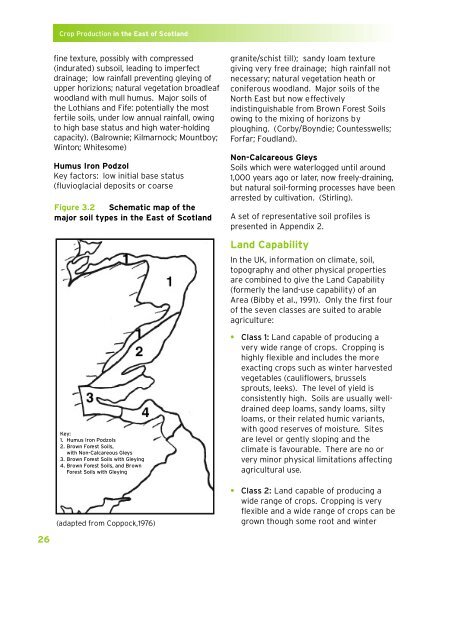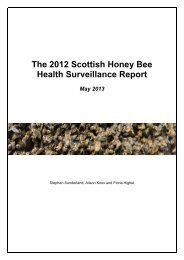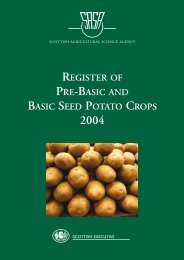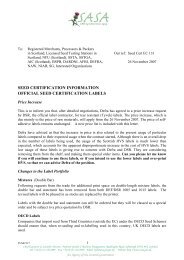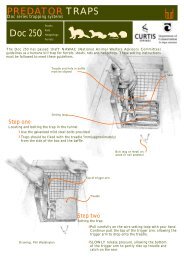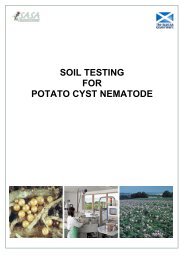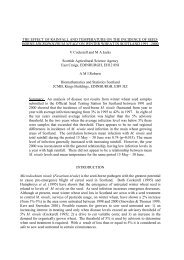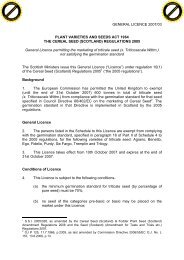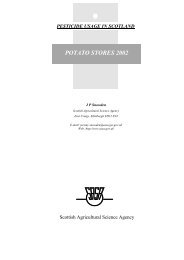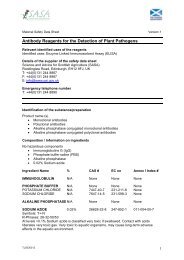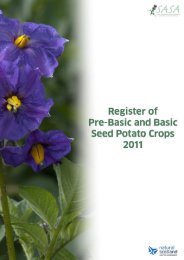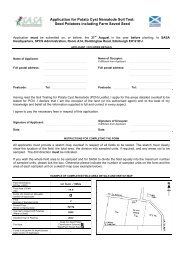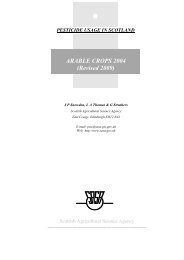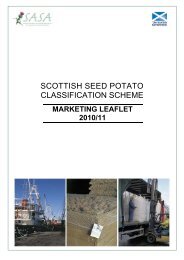Geology, Soils and Land Capability<strong>of</strong> till/drift over <strong>the</strong> lowlands <strong>of</strong> <strong>the</strong> <strong>East</strong> <strong>of</strong><strong>Scotland</strong>. The orig<strong>in</strong> <strong>of</strong> <strong>the</strong> till dependsupon <strong>the</strong> direction <strong>of</strong> movement <strong>of</strong> <strong>the</strong> icesheets and glaciers. In <strong>the</strong> South <strong>of</strong><strong>Scotland</strong>, <strong>the</strong> direction <strong>of</strong> movement waspredom<strong>in</strong>antly west to east, with <strong>the</strong> resultthat much <strong>of</strong> <strong>the</strong> till cover<strong>in</strong>g <strong>the</strong> Lothians,<strong>the</strong> Merse and <strong>the</strong> sou<strong>the</strong>rn half <strong>of</strong> Fife is<strong>of</strong> Carboniferous orig<strong>in</strong>. Fur<strong>the</strong>r north, <strong>the</strong>direction was more north to south, suchthat <strong>the</strong> till cover<strong>in</strong>g Tayside (Perth andAngus) is ma<strong>in</strong>ly <strong>of</strong> ORS orig<strong>in</strong>, as shown by<strong>the</strong> dist<strong>in</strong>ct red soils <strong>of</strong> <strong>the</strong> area. There arealso significant areas where <strong>the</strong> till iscomposed <strong>of</strong> igneous material <strong>of</strong> ORS age(e.g. N. Fife). The lowlands <strong>of</strong> Banff andAberdeenshire are covered with till fromDalradian and igneous rocks carriedeastwards. There are pronounced localdifferences; for example, <strong>the</strong> fourextensive soil associations <strong>of</strong> arableAberdeenshire are formed on tills <strong>of</strong>contrast<strong>in</strong>g chemistry (Foudland: Dalradianschist; Insch: mixed till <strong>of</strong> gabbro andschist; Tarves: mixed till <strong>of</strong> acid and basicigneous rocks; Countesswells: granite till;Table 3.1), each relat<strong>in</strong>g to <strong>the</strong> “upstream”geology. F<strong>in</strong>ally, <strong>the</strong> direction <strong>of</strong> flow <strong>in</strong> <strong>the</strong>Moray Firth area was south west to nor<strong>the</strong>ast, such that <strong>the</strong> till is made up <strong>of</strong>Mo<strong>in</strong>ian schist and granite.Two o<strong>the</strong>r aspects <strong>of</strong> <strong>the</strong> glaciation <strong>of</strong> <strong>the</strong><strong>East</strong> <strong>of</strong> <strong>Scotland</strong> are important for soilformation. First, <strong>the</strong> mass <strong>of</strong> ice wasparticularly great on <strong>the</strong> Nor<strong>the</strong>rn and<strong>East</strong>ern Highlands, with <strong>the</strong> result thatfluvioglacial processes, which washed out<strong>the</strong> f<strong>in</strong>er components <strong>of</strong> <strong>the</strong> till, were veryactive and prolonged dur<strong>in</strong>g <strong>the</strong> period <strong>of</strong>deglaciation. Thus <strong>the</strong>re are moreextensive areas <strong>of</strong> fluvioglacial sands andsandy loams <strong>in</strong> <strong>the</strong> nor<strong>the</strong>rn half <strong>of</strong> <strong>the</strong>study area, and particularly <strong>in</strong> <strong>the</strong> Laich <strong>of</strong>Moray (Corby/Boyndie Soil Association;Table 3.1), than <strong>in</strong> <strong>the</strong> sou<strong>the</strong>rn half.Secondly, <strong>the</strong> weight <strong>of</strong> ice press<strong>in</strong>g onlodgement till, has tended to compress <strong>the</strong>material, with <strong>the</strong> result that most soils,even those with relatively coarse textures,have subsoils with lower hydraulicconductivities than would be predictedfrom <strong>the</strong>ir texture.SoilsThe soil types which have formed from thisvariety <strong>of</strong> parent materials over 10,000years depend upon <strong>the</strong> <strong>in</strong>teractions <strong>of</strong>several factors:• <strong>the</strong> texture <strong>of</strong> <strong>the</strong> parent material• its base status• its hydraulic conductivity• topography• annual precipitation• vegetation (mull or mor humus)which determ<strong>in</strong>e <strong>the</strong> degree and type <strong>of</strong>leach<strong>in</strong>g and/or waterlogg<strong>in</strong>g <strong>of</strong> <strong>the</strong> soilpr<strong>of</strong>ile. These processes have producedfour major arable soil types, to which mustbe added <strong>the</strong> more recent alluvial soils(Table 3.1; Figure 3.2):Brown Forest SoilKey factors lower<strong>in</strong>g <strong>the</strong> rate <strong>of</strong> leach<strong>in</strong>g,and prevent<strong>in</strong>g podzolisation orwaterlogg<strong>in</strong>g: high <strong>in</strong>itial base status,particularly with igneous components;sandy loam to loam texture; free but notexcessive dra<strong>in</strong>age; natural vegetationbroadleaf woodland with mull humus. Moreprevalent <strong>in</strong> <strong>the</strong> sou<strong>the</strong>rn half <strong>of</strong> <strong>the</strong> studyarea. (Carpow/Panbridge; Darleith; Darvel;Hobkirk; Insch; Sourhope; Tarves)Brown Forest Soil with Gley<strong>in</strong>gKey factors: high <strong>in</strong>itial base status(particularly Carboniferous till); medium to25
<strong>Crop</strong> <strong>Production</strong> <strong>in</strong> <strong>the</strong> <strong>East</strong> <strong>of</strong> <strong>Scotland</strong>26f<strong>in</strong>e tex tu re, possibly with co m p resse d( i n d u ra ted) subsoil, lead<strong>in</strong>g to imperfe c td ra<strong>in</strong>age; low ra i nfall preve nt<strong>in</strong>g gley<strong>in</strong>g <strong>of</strong>upper horizions; natu ral ve g etation broa d l ea fwoodland with mull humus. Major soils <strong>of</strong><strong>the</strong> Lothians and Fife: pote ntially <strong>the</strong> mostfe rtile so i l s, under low annual ra i nfall, ow i n gto high ba se sta tus and high wa te r- h o l d i n gca pa c i ty). (Ba l rownie; Kilmarnock; Mount b oy ;Wi nton; Wh i teso m e)Humus Iron PodzolKey factors: low <strong>in</strong>itial base status(fluvioglacial deposits or coarseFigure 3.2 Schematic map <strong>of</strong> <strong>the</strong>major soil types <strong>in</strong> <strong>the</strong> <strong>East</strong> <strong>of</strong> <strong>Scotland</strong>Key:1. Humus Iron Podzols2. Brown Forest Soils,with Non-Calcareous Gleys3. Brown Forest Soils with Gley<strong>in</strong>g4. Brown Forest Soils, and BrownForest Soils with Gley<strong>in</strong>g(adapted from Coppock,1976)granite/schist till); sandy loam texturegiv<strong>in</strong>g very free dra<strong>in</strong>age; high ra<strong>in</strong>fall notnecessary; natural vegetation heath orconiferous woodland. Major soils <strong>of</strong> <strong>the</strong>North <strong>East</strong> but now effectively<strong>in</strong>dist<strong>in</strong>guishable from Brown Forest Soilsow<strong>in</strong>g to <strong>the</strong> mix<strong>in</strong>g <strong>of</strong> horizons byplough<strong>in</strong>g. (Corby/Boyndie; Countesswells;Forfar; Foudland).Non-Calcareous GleysSoils which we re wa terlogged until aro u n d1 ,000 yea rs ago or late r, now fre e l y- d ra i n i n g ,but natu ral so i l - form<strong>in</strong>g pro cesses have beena r rested by cu l t i vation. (St i r l i n g ) .A set <strong>of</strong> representative soil pr<strong>of</strong>iles ispresented <strong>in</strong> Appendix 2.Land CapabilityIn <strong>the</strong> UK, <strong>in</strong>formation on climate, soil,topography and o<strong>the</strong>r physical propertiesare comb<strong>in</strong>ed to give <strong>the</strong> Land Capability(formerly <strong>the</strong> land-use capability) <strong>of</strong> anArea (Bibby et al., 1991). Only <strong>the</strong> first four<strong>of</strong> <strong>the</strong> seven classes are suited to arableagriculture:• Class 1: Land capable <strong>of</strong> produc<strong>in</strong>g avery wide range <strong>of</strong> crops. <strong>Crop</strong>p<strong>in</strong>g ishighly flexible and <strong>in</strong>cludes <strong>the</strong> moreexact<strong>in</strong>g crops such as w<strong>in</strong>ter harvestedvegetables (cauliflowers, brusselssprouts, leeks). The level <strong>of</strong> yield isconsistently high. Soils are usually welldra<strong>in</strong>eddeep loams, sandy loams, siltyloams, or <strong>the</strong>ir related humic variants,with good reserves <strong>of</strong> moisture. Sitesare level or gently slop<strong>in</strong>g and <strong>the</strong>climate is favourable. There are no orvery m<strong>in</strong>or physical limitations affect<strong>in</strong>gagricultural use.• Class 2: Land capable <strong>of</strong> produc<strong>in</strong>g awide range <strong>of</strong> crops. <strong>Crop</strong>p<strong>in</strong>g is veryflexible and a wide range <strong>of</strong> crops can begrown though some root and w<strong>in</strong>ter


